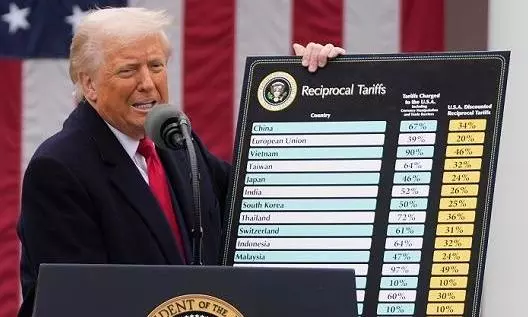
With US Supreme Court set to hear Trump tariffs, world hopes for a miracle
‘Supermajority’ of conservative judges and Trump’s options to invoke laws other than emergency power to keep tariffs high pose two big challenges

The world’s attention veers to the US Supreme Court on Wednesday (November 5), when it will begin hearing the challenges to US President Donald Trump’s power to use an emergency law to impose high tariffs on countries without the US Congress’s approval.
For the first time in US history, a president has invoked the Internal Emergency Economic Powers Act (IEEPA) of 1977 to impose high “reciprocal” tariffs since February 2, 2025 (he called it the “liberation day”) on a number of countries, including India.
Why expectations are low
The judgement is not expected before January 2026 and the expectations are very low for two major reasons.
One, as news agency Reuters quoted Treasury Secretary Scott Bessent as saying on Tuesday, Trump has the options to “switch” to other tariff authorities, including the Trade Act of 1974, which allows broad 15 per cent tariffs for 150 days to check trade imbalances, and the Tariff Act of 1930, which allows tariffs up to 50 per cent on countries that discriminate against US commerce.
Also read: Trump warns US could face ‘Third World status’ if SC strikes down tariffs
Bessent’s parting line was: “You should assume that they’re (high tariffs) here to stay.”
The other is what the US legal fraternity calls “conservative supermajority” (six-to-three) in the apex court, which has backed many of Trump’s major moves this year, including stripping temporary protected status from thousands of immigrants, firing thousands of federal employees despite contractual protections and stopping foreign aid.
Meanwhile, Trump has warned of an economic catastrophe if the court ruled his tariffs unconstitutional.
World hopes for a miracle
Even so, the rest of the world would be hoping for a miracle, or call it a “golden swan” event if you may, which may dent the whimsical run of Trump’s unilateral tariffs, including on major and traditional trade partners like the EU, the UK, Canada and Mexico, to clinch one-sided terms of trade.
Trump has single-handedly dismantled the rule-based global trading regime, whosoever imperfect that may have been.
Also read: In Busan, how Xi outplayed Trump in the long game for global power
Stakes are also high for domestic businesses, citizens, and several states that are opposed to Trump’s tariffs — even as his administration fills its coffers with an additional $20 billion a month, expecting to collect over $500 billion in extra (in Treasury Secretary Scott Bessent’s assessment).
Trump’s logic for imposing high tariffs is mounting (goods) trade deficits, which touched $1.2 trillion in 2024, calling it a national emergency and need to be cut down to avoid a balance of payment crisis. He has used the tariff walls to coerce countries to invest in the US to boost its manufacturing and jobs.
Main question before the US apex court
At the heart of the legal challenge is Trump’s use of IEEPA without involving the US Congress.
A US Congressional Research Service brief of September 1, 2025, says the IEEPA “provides the President broad authority to regulate a variety of economic transactions following a declaration of national emergency” but also adds that “prior to 2025, no President had used IEEPA to impose tariffs”.
It says that beginning in February 2025, Trump invoked the IEEPA to impose tariffs to deal with “six distinct national emergencies”, including fentanyl trafficking, import of Venezuelan oil, “persistent annual United States goods trade deficits”, and “violations of the free expression rights of US persons”.
Also read: Piyush Goyal says no India-US trade deal without safeguards for farmers, MSMEs
It does mention that President Richard Nixon had imposed 10 per cent ad valorem tariff on imports in 1971 “to avoid a balance of payments crisis after he ended the convertibility of the US dollar to gold”, but that was under the Trading with the Enemy (TWEA) Act of 1917.
It points out that several members of the Congress have moved resolutions to terminate national emergencies used for the tariffs and bills to restrict the President’s power; the US Court of International Trade found, in May 2025, that several tariff actions were not authorized under IEEPA and, in August, the US Court of Appeals for the Federal Circuit held that Trump’s actions “exceed the authority delegated to the President by IEEPA’s text”.
The Trump administration has challenged such court verdicts in the apex court.

